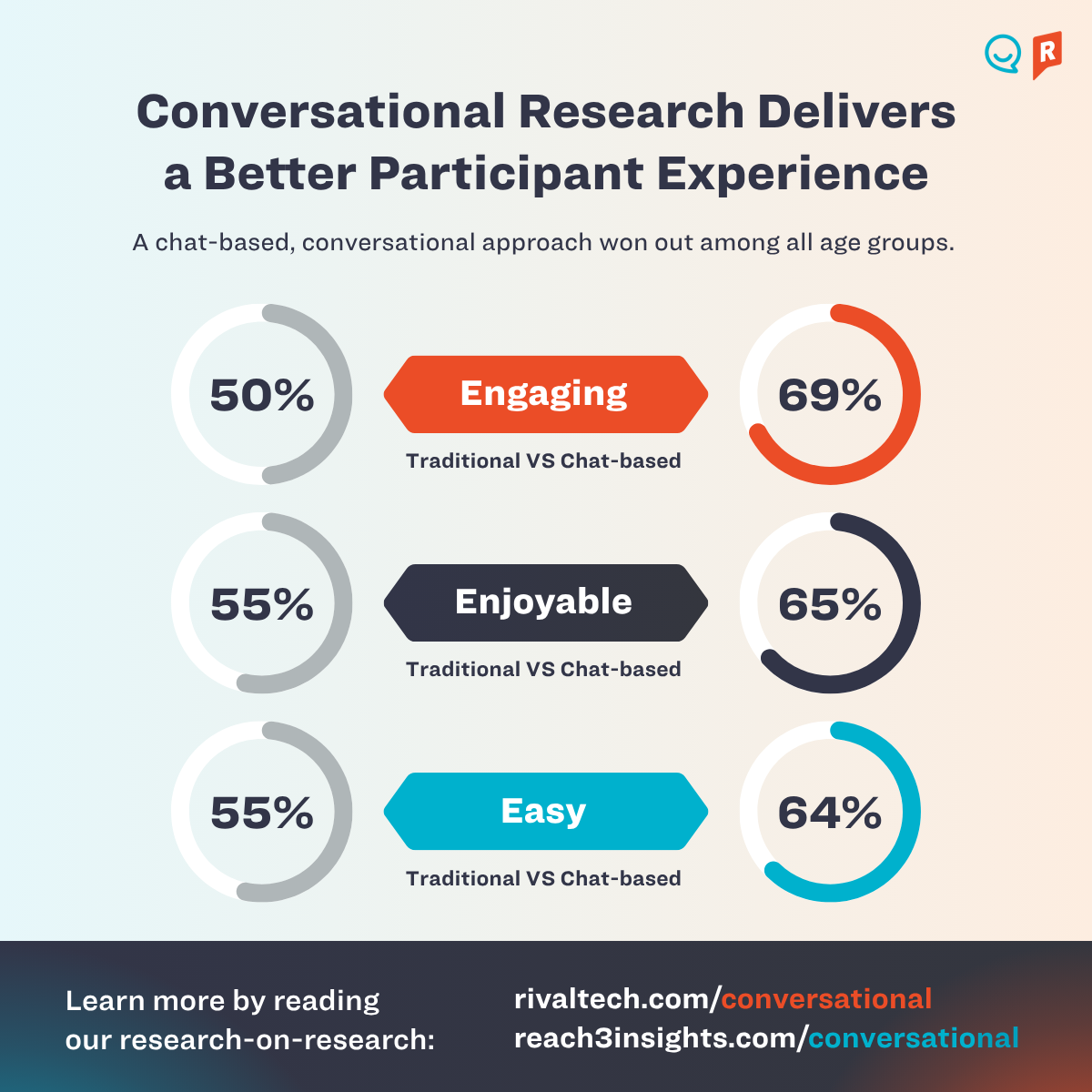
In a world flooded with ads, emails, and endless content, consumer attention has become the rarest—and most valuable—currency. Yet most brands still try to win it with brute force: more content, more touchpoints, more boring surveys, more noise.
As Andrew Reid, CEO and Founder of Rival Technologies, writes in Entrepreneur, “It now takes an average of eight touchpoints to make a sale—and most of those only frustrate people.”
Andrew argues it’s time to replace outdated, volume-based marketing with strategies grounded in human behavior and emotional connection. Drawing from both data and experience, he identifies five key drivers of engagement that can help brands cut through the clutter and build genuine loyalty.
For insights professionals, these same drivers offer a framework for capturing the attention of both participants and stakeholders.
People don’t want more content—they want a show.
Humor and creativity make marketing memorable. Andrew points to examples like the ALS Ice Bucket Challenge or Pit Viper’s irreverent 90s-style campaigns as proof that entertainment drives engagement. Research backs this up: 90% of consumers remember funny ads, according to Oracle.
This point is especially relevant for the research industry, which is often associated with long, formal surveys and dense PowerPoint decks. Not exactly entertaining experiences. 🤷♂️
That’s why conversational research matters. Our research-on-research shows that people across all age groups find chat-style approaches more enjoyable, engaging, and easy.

As Mary Ann Fitzgerald, Director of Consumer Insights at Balsam Brands, shared in a recent webinar, conversational methods “create consumer closeness” and drive engagement and retention.
Action for insights leaders: Stop sending boring surveys. Treat research like a conversation, not an interrogation. And don’t bore your stakeholders either—use better storytelling techniques to make your insights engaging and memorable.
Modern consumers crave knowledge—but only if it’s delivered in snackable, relatable ways. Brands like HubSpot and Casper have mastered this by combining useful information with personality.
Andrew emphasizes that educational content builds credibility and helps people make better decisions. But the key is knowing what your audience wants to learn—and how they want to learn it. Traditional surveys can’t always capture that nuance.
Action for insights leaders: We’re always asking participants for feedback—but what if we also share back what we’ve learned? The best insight communities on the Rival platform do this regularly, sharing interesting stats or findings that make members feel valued and informed.
The best brands understand that engagement isn’t just about consumption—it’s about identity. When people share your content, they’re sharing something about themselves.
Andrew points to brands like Fenty Beauty and Apple, whose Shot on iPhone campaign made users the heroes of the story. Coca-Cola’s “Share a Coke” campaign did the same, boosting sales in the U.S. by over 2% simply by giving people a reason to see themselves in the product.
These marketing campaigns aren’t random wins—they tap into a powerful truth: people share things that make them look smart, funny, or connected to something bigger.
“The brands that understand this create content people want to share because it makes them look good in the process — and creates loyalty while they’re at it,” Andrew explains.
Social clout isn’t about chasing virality—it’s about helping your audience feel proud of their association with your brand, and making it effortless to share that pride.
Action for insights leaders: Create a research experience participants are proud to be part of. If you run a branded insight community, give members meaningful titles like “ambassadors” or “insiders.” This signals that their role is special and reinforces their connection to your brand.
Humans are wired to crave progress. Whether it’s a streak on Duolingo or a Peloton badge, small wins keep people motivated. Andrew recalls the “rush of achieving” even as a child earning a sticker at school: “That little reward gave me a confidence boost.”
For marketers, this means designing experiences that help customers feel successful—whether it’s completing a challenge, unlocking new content, or being recognized for participation.
"It’s not just about selling," Andrew explains. "It’s about helping people feel like they did something today that mattered, even if it was just sharing a milestone or leveling up."
Action for insights leaders: Design research activities that leave participants feeling accomplished. Many Rival customers use emojis or affirmations at the end of their conversational surveys to celebrate completion and thank participants for their input. Small gestures make a big difference.
Yes, people love rewards—but only when they feel personal and meaningful. Andrew highlights Starbucks as a brand that gamified loyalty, turning everyday purchases into moments of achievement.
Still, not all incentives work. As Andrew notes, “The most successful programs aren’t built on trends or CMO hunches—they’re built from real conversations with customers.”
Action for insights leaders: In research, incentives work because they are incentivizing. Rewards don’t have to be expensive—if you're using a top insight community platform, you can use simple contests or token gifts (like swag from your brand) to reward people. Just be clear about how winners are chosen; transparency builds trust, which drives recontact and retention.
In his article, Andrew argues that marketing has become generic. Brands try everything and hope something sticks. But in a fragmented world where attention spans are shrinking and consumer expectations are changing, that approach won’t work.
The solution? Get closer to your consumers.
“To find out which drivers will resonate with your audiences, stop skipping the most critical step: comprehensive consumer insights programs that employ research techniques that deliver authentic, quality data.... Ask your customers what really matters, listen to their answers, and build your strategy around those insights.”
In the end, winning in the attention economy comes down to connection. Whether you’re a marketer or an insights professional, your job is to help people feel seen, valued, and inspired to engage. And that’s what really matters.

No Comments Yet
Let us know what you think